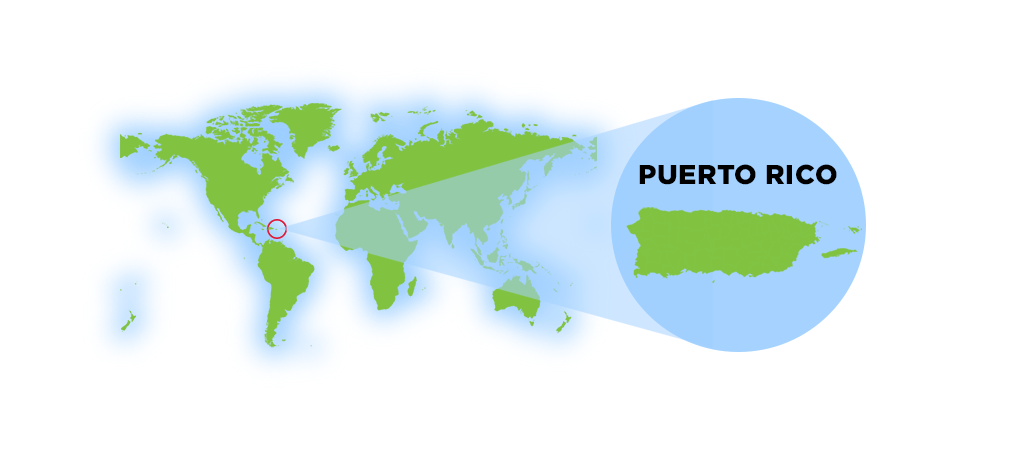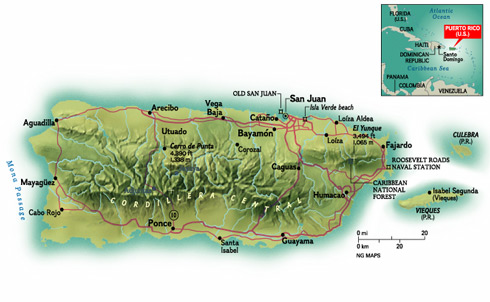Geography of Puerto Rico
The island of Puerto Rico is a very popular tourist destination because of its location, rich history and warm atmostphere. The island is located in the Caribbean, between the Caribbean Sea and the North Atlantic Ocean, east of the Dominican Republic, about 1,000 miles (1,600 km) southeast of Miami, Florida. Puerto Rico is one of the 28 islands in the Caribbean.
Puerto Rico is almost rectangular in shape, approximately 100 miles long by 35 miles wide and is the smallest and the most eastern island of the Greater Antilles (Cuba, Hispaniola, Jamaica and Puerto Rico).
Although, often referred an island, Puerto Rico is an archipelago formed by the main island and 143 small islands, islets and cays, including Vieques, Culebra, Culebrita, Palomino, Mona, and Monito. Vieques and Culebra are also known by some by the Spanish Virgin Islands, formerly called the Passage Islands and also known as the Puerto Rican Virgin Islands.
Its coasts measures approximately 580 km, and if the adjacent islands Vieques and Culebra are included the coast measures approximately 700 km. With an area of 3,425 square miles (9,104 sq km), Puerto Rico is the third largest island in the United States and the 82nd largest island in the world.
Geographic Coordinates: Latitude: 18° 15" N Longitude: 66° 30" W
Total Area:
9,104 sq km (3,508 sq mi)
The maximum length from east to west (from Punta Puerca to Punta Higuero) of 180
km (110 mi) and with a maximum width from north to south (from Isabella to Punta
Colón) of 65 km (40 mi).
Land Area: 8,959 sq km
Comparative Area: Puerto Rico is approximately three times the size of Rhode Island and 1,080 times smaller than the United States.
Water Area: 145 sq km
Region: North America
Subregion: Caribbean
Map References: Central America and the Caribbean
Interesting Fact
Puerto Rico is close to the deepest submarine depression in the
North Atlantic Ocean (second in the world). The Puerto Rico Trench, roughly parallel to the
northern coast of the island of Puerto Rico and lying about 75 miles
(120 km) to the north. The Puerto Rico Trench is about 1,090 miles
(1,750 km) long and 60 miles (100 km) wide. The deepest point in the
Atlantic Ocean, the Milwaukee Depth, lies within the Puerto Rico
Trench, at a depth of 27,493 feet (8,380 meters) in the western end of the trench,
about 100 miles (160 km) northwest of Puerto Rico.
The origin of the trench can be traced back to the beginning of the
Tertiary period. The Puerto Rico Trench appears to be part of a
complex system of sinistral strike-slip faults in the north
Caribbean; the trench seems to have been opened continuously for
about 70 million years. It is partially filled with sediments.
The Caribbean's greatest known depth is Cayman Trench (Bartlett Deep) between Cuba and Jamaica, at approximately 25,216 feet (7,686 meters) below sea level.
Limits:
To the west by Haití and the Dominican Republic (La
Hispañola), separated by the Mona Passage ("Mona Canal"), to
the east by the Virgin Islands, to the north by the Atlantic Ocean, and to the
south by the Caribbean Sea.
Land boundaries: 0 km
Coastline: 501 km
Borders:
Puerto Rico is under the U.S. customs jurisdiction. Borders are
open between P.R. and the U.S., allowing for free movement of people and
merchandise.
Maritime Claims:
Continental shelf: 200 NM (depth)
Exclusive economic zone: 200 NM
Territorial sea: 12 NM
Geology
Puerto Rico is composed of Jurassic to Eocene volcanic and plutonic rocks, which are overlain by younger Oligocene to recent carbonates and other sedimentary rocks. Most of the caverns and karst topography on the island occurs in the northern Oligocene to recent carbonates. The oldest rocks are approximately 190 million years old (Jurassic) and are located at Sierra Bermeja in the southwest part of the island.
Puerto Rico lies at the boundary between the Caribbean and North American plates. This means that it is currently being deformed by the tectonic stresses caused by the interaction of these plates.
Interesting Fact
70.8% of the world's surface is water, 29.2% is land.
Deep oceans waters fringe Puerto Rico. To the west, the Mona Passage, which separates the island from Hispaniola to the west, is about 80 miles (130 km) wide and more that 3,300 feet (1,000 meters) deep. Off the northern coast in the Atlantic Ocean at the boundary between the Caribbean and North American plates is the Puerto Rico Trench, the largest and deepest trench in the Atlantic. The trench is 800 kilometres (497 mi) long and has a maximum depth of 8,000 metres (26,247 ft) at Milwaukee Deep, which is the deepest point in the Atlantic Ocean. To the south the sea bottom descends to the 16,400 feet (5,000 meters) deep Venezuelan Basin of the Caribbean.
Because of the proximity to the two tectonic plates Puerto Rico experiences an average of five earthquakes (including aftershocks) with a magnitude greater than 1.5 occurring near per day.
Although the vast majority of these earthquakes are too small to be felt by people, but provides evidence that the North American plate is moving westward relative to the Caribbean plate at about two centimeters per year.
Topography
The territory is very mountainous (covering about 60%), except in the regional coasts, but Puerto Rico offers astonishing variety: rain forest, deserts, beaches, caves, oceans and rivers. Puerto Rico has three main physiographic regions: the mountainous interior, the coastal lowlands, and the karst area.
The mountainous interior is formed by a central mountain chain commonly known as the Cordillera Central, extending across the interior of the island, from Mayagüez to Aibonito, which transects the island from east to west. These mountain ranges are La Cordillera Central, La Sierra de Cayey, La Sierra de Luquillo, and La Sierra Bermeja.
The highest mountains are Cerro La Punta (1,338 m) in Jayuya; Rosas (1,267 m) found between Jayuya and Ciales, Guilarte (1,205 m) in Adjuntas, Tres Picachos (1,204 m) in Jayuya, and Maravilla (1,182m) in Ponce. Toward to the northeast is Sierra de Luquillo, whose highest peaks are: Toro Hill (1,074 m) found between Río Grande, Naguabo and Las Piedras, and El Yunque Peak (1,065 m) found in Río Grande. Another mountain chain is the Sierra de Luquillo in the northeast.
The second main physiographic feature is the coastal lowlands, which extend 13 to 19 km (8 to 12 mi) inward in the north and 3 to 13 km (2 to 8 mi) in the south. A series of smaller valleys lie perpendicular near the west and east coast. This area was originally formed by the erosion of the interior mountains.
The third important physiographic feature is the karst region in the north. This area consists of formations of rugged limestone dissolved by water throughout the geological ages. This limestone region is an extremely attractive zone of extensive mogotes or haystack hills, sinkholes, caves, limestone cliffs, and other karst features. The karst belt extends from Aguadilla, in the west, to a minor haystack hills formation in Loíza, just east of San Juan.
Yunque National Forest
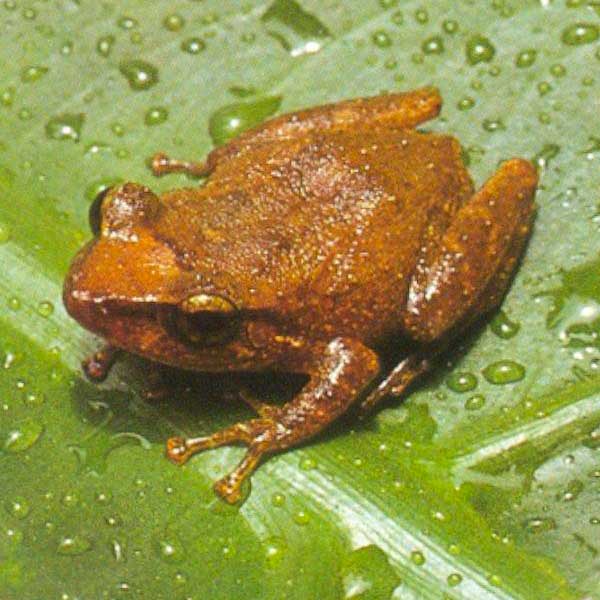
The Yunque National Forest, formerly known as the Caribbean National Forest is located on the slopes of the Sierra de Luquillo mountains in northeastern Puerto Rico. Covering over 28,000 acres, it is the last remaining tropical rainforest in the U.S. National Forest System and a UNESCO-designated Biosphere Reserve. Once part of a vast rainforest that covered much of the island and the northern Caribbean, El Yunque now stands as a biodiversity hotspot.
Receiving over 200 inches (100 billion gallons) of rain annually, this lush ecosystem is home to an incredible variety of flora and fauna. A hike or horseback ride through its misty trails reveals over 240 tree species—some thousands of years old—alongside 50 fern species, 20 varieties of wild orchids, and a stunning array of tropical flowers.
One of El Yunque’s most iconic inhabitants is the coquí, a tiny tree frog measuring just 0.25 to 1 inch in size. The name is derived from his cricket like "ko-kee" chirp, the coquí is a beloved national symbol of Puerto Rico and can be heard throughout the island at night.
Other Notable Forests in Puerto Rico
While El Yunque is the most famous, Puerto Rico is home to several other unique forest ecosystems:
- Guajataca State Forest (Northwest) – Known for limestone caves, scenic trails, and diverse bird species.
- Río Abajo Forest (Between Arecibo & Utuado) – Features karst formations, caves, and endangered Puerto Rican parrots.
- Aguirre Forest (South) – A mangrove and coastal forest vital for wetland conservation.
- Piñones State Forest (East of San Juan) – A mangrove and coastal ecosystem, ideal for kayaking and biking.
- Guánica Dry Forest (West of Ponce) – A UNESCO Biosphere Reserve, home to over 700 plant species, 48 endangered species, and 16 species found nowhere else. It is also a top birdwatching destination with the largest number of bird species in Puerto Rico.
- Maricao, Guilarte, Toro Negro & Carite Forests – These forests along the Panoramic Route offer cooler mountain climates, waterfalls, and diverse hiking opportunities.
Puerto Rico’s forests showcase the island’s incredible ecological diversity, from tropical rainforests to dry coastal reserves, offering nature lovers endless opportunities to explore and discover.
Caves & Unique Ecosystems
Puerto Rico is home to some of the most significant cave systems in the Western Hemisphere. Among them is the Río Camuy Cave Park (Parque Nacional de las Cavernas del Río Camuy), where the Río Camuy—the third-largest subterranean river in the world—flows underground for part of its course. The park features:
- Impressive stalactites & stalagmites
- Deep sinkholes & caverns, some over 200 feet (60 meters) deep
- Rare cave-dwelling species, including bats, cave crickets, and blind fish
- Taino petroglyphs, carved into the cave walls, offering a glimpse into Puerto Rico’s indigenous history
- Location: Near Lares and Camuy, on Route 129, Km 9.8
- Hours: Open Wednesday to Sunday
- Admission: $18 for adults, $13 for children (prices may vary)
- Contact: (787) 898-3100
- Guided Tours: Visitors can explore the main cave system, including the Cathedral Cave and the enormous Clara Cave, which features a massive sinkhole opening to the sky.
Cueva del Infierno – A Hidden Gem with Over 2,000 Caves
Located nearby, Cueva del Infierno is part of a larger karst cave network, where over 2,000 caves have been discovered. Unlike Río Camuy, this cave system is less developed for tourism, making it an ideal spot for adventure seekers and spelunkers. The cave features:
- Home to 13 bat species
- The famous coquí frog, known for its distinctive "ko-kee" call
- Cave crickets & blind fish
- The "guavá" – a rare arachnid unique to the island
Guided Tours Available: For adventure caving and spelunking experiences, call (787) 898-2723.
Close to Río Camuy, you’ll find Cueva del Infierno, part of a vast cave system where over 2,000 caves have been discovered. These caves are home to 13 bat species, the coquí frog, cave crickets, and the rare arachnid "guavá."
Additional Notable Caves in Puerto Rico
Cueva Ventana ("Window Cave") – The Most Photographed View in Puerto Rico
- Located in Arecibo, this cliffside cave opens up to a stunning panoramic view of the Río Grande de Arecibo valley.
- Features Taino petroglyphs, showcasing Puerto Rico’s indigenous heritage.
- Guided tours available for both eco-tourists and history lovers.
- Location: PR-10, Km 75, Arecibo
- Hours: Daily, 10 AM – 4 PM
- Admission: Approx. $20 per person
- Contact: (787) 322-3554
Cueva del Indio – Taino Rock Art & Coastal Beauty
- Located along the coast of Arecibo, this cave contains some of the island’s most well-preserved Taino petroglyphs.
- Offers breathtaking ocean views with dramatic limestone cliffs.
- Used as a filming location for Hollywood movies like Pirates of the Caribbean.
- Location: PR-681, Arecibo
- Admission: $5 parking fee (self-guided access)
Cueva Clara & Tres Pueblos Sinkhole – Extreme Caving Adventure
- Located near Río Camuy Cave Park, but only accessible via special guided spelunking tours.
- The Tres Pueblos Sinkhole is over 400 feet (120 meters) deep, requiring rappelling equipment for exploration.
- Not for beginners – best suited for experienced cavers!
- Contact for Extreme Tours: (787) 999-2200
Why Visit Puerto Rico’s Caves?
Puerto Rico’s cave systems offer something for everyone—whether you're a history buff, nature lover, adventure seeker, or photographer:
- Discover Taino petroglyphs & indigenous history
- See rare cave wildlife & underground ecosystems
- Experience breathtaking views of valleys & coastlines
- Go beyond the tourist spots with extreme caving tours
From the famous Río Camuy Cave Park to hidden gems like Cueva del Indio and Cueva Ventana, Puerto Rico’s caves are a must-visit for any explorer!
Interesting Fact
The islands of Cayo Diablo, St. Thomas, St. John, Tortola,
Guana, Greater Camanoe, Necker Cay, and Virgin Gorda
were once known as the Puerto Rico Bank.
Mona Island: Puerto Rico’s Untouched Natural Treasure
Another unique environment can be found on Mona Island, 50 miles off the west coast of Puerto Rico. Like the Galapagos Islands, this untouched island has species which are not found elsewhere. Mona is a protected island, under the management of the United States National Park Service and the Puerto Rican Natural Resources Department. Accessible by a sometimes difficult, long boat ride, the island is available for sport diving to those who make special arrangements and are willing to rough it out.
Terrain & Soil Classification of Puerto Rico
Puerto Rico's diverse landscape results in a variety of soil types, classified differently depending on the approach used.
Different classification schemes exist for the soils of Puerto Rico. One physiographic approach, based on a scientific classification by the U.S. Soil Conservation Service, can be summarized into five general soil types: humid coastal plains, semiarid coastal plains, humid uplands, semiarid uplands, and humid upland valleys. Another classification by soil scientists at the University of Puerto Rico groups the island's soils into coastal lowlands, alluvium, coastal plains, alluvium in terraces, upland dark, and upland reddish-purple.
Agricultural Potential of Puerto Rico’s Soils
Although tropical soils are sometimes seen as infertile and poor for agriculture, Puerto Rico’s soil diversity has sustained productive farming for centuries. Certain crops thrive in specific soil types due to drainage, moisture retention, and mineral composition.
Best Crops by Soil Type
- Alluvial (Floodplain) Soils – Ideal for: bananas, plantains, yams, taro, and root crops
- Coastal Plains & Lowlands – Used for: coconuts, citrus fruits, mangoes, and pineapples
- Humid Uplands & Valleys – Perfect for: coffee, cacao, and tobacco
- Semiarid Coastal & Upland Soils – Used for: sorghum, legumes, and livestock grazing
Impact of Deforestation & Soil Erosion
Puerto Rico's mountainous terrain and heavy seasonal rainfall make soil erosion a major environmental concern. Over time, deforestation, urbanization, and agricultural expansion have led to:
- Loss of fertile topsoil, affecting crop productivity.
- Increased sedimentation in rivers, impacting water quality.
- Landslides in steep areas, particularly in deforested regions.
To combat these issues, soil conservation efforts such as reforestation programs, contour farming, and terracing are being implemented to preserve the island’s agricultural capacity and natural ecosystems.
Elevation
Mean Elevation:261 m
Highest Point: Cerro Punta, 1,338 m (4,389 ft)
Lowest Point: Sea level, Caribbean Sea 0 m
Rivers and Lakes of Puerto Rico
Puerto Rico’s unique east-west mountain range, La Cordillera Central, greatly influences the flow and characteristics of its rivers. Due to the island’s relatively small size, Puerto Rico does not have long rivers or large natural lakes, but it does have a complex system of rivers, reservoirs, and lagoons that play a crucial role in water supply, agriculture, and hydroelectric power.
Rivers of Puerto Rico
Puerto Rico's rivers vary significantly between the north and south due to the island’s topography and rainfall patterns.
Northern & Western Rivers – Longer and Slower Flowing
Rivers in the north tend to be longer, with slow-moving currents, as they receive more rainfall and flow toward the Atlantic Ocean. The longest river on the island is:
- Río Grande de Arecibo – The longest river in Puerto Rico, flowing to the northern coast.
Other major rivers flowing north include:
- Río La Plata – One of the island’s largest, running from the mountains to the Atlantic.
- Río Cibuco – A significant waterway for northern agriculture.
- Río Loíza – The largest river by volume, supplying water to the San Juan metropolitan area.
- Río Bayamón – A major river in the north that supports urban and industrial areas.
Rivers flowing westward into the Mona Passage include:
- Río Grande de Añasco – One of the most significant rivers on the west coast.
Most northern and western rivers maintain perennial (year-round) water flow due to higher rainfall levels in these regions.
Southern Rivers – Shorter and Fast-Flowing
Rivers in the south are generally shorter, steeper, and have stronger currents, as this region receives less rainfall. Many run dry for most of the year but can cause flash flooding after heavy rains. Key southern rivers include:
- Río Portugués – One of the few perennial rivers in the south.
- Río Loco – Known for its seasonal flow.
- Río Coamo – Famous for its nearby hot springs.
- Río Grande de Patillas – A vital water source for the southeastern region.
Lakes and Reservoirs of Puerto Rico
Puerto Rico does not have any natural lakes but has 15 artificial reservoirs (commonly called "lakes"), created by damming major rivers to supply hydroelectric power, irrigation, and drinking water.
Key Reservoirs in Puerto Rico
- Lago La Plata – One of the island’s largest reservoirs, supplying water to San Juan.
- Lago Dos Bocas – A scenic lake popular for boat tours.
- Lago Carraízo – A primary water source for the metropolitan area.
- Lago Guajataca – Provides drinking water to northwestern Puerto Rico.
- Lago Lucchetti – Important for irrigation and hydroelectric power.
Hydroelectric power accounts for less than 1% of Puerto Rico’s electricity, as most power is generated using petroleum-based energy sources.
Natural Lagoons of Puerto Rico
Puerto Rico does have several natural lagoons, which serve as critical ecosystems for wildlife, fishing, and recreation. Some of the most notable include:
- Laguna del Condado (San Juan) – A popular spot for kayaking and paddleboarding.
- Laguna San José (San Juan) – A significant mangrove ecosystem.
- Laguna Piñones & Laguna Torrecillas (Carolina) – Both located in a protected coastal area with rich biodiversity.
- Laguna Joyuda (Cabo Rojo) – The largest coastal lagoon in Puerto Rico, known for its fishing industry.
- Laguna Tortuguero (Manatí) – The largest freshwater lagoon on the island, home to many endangered species.
Water Conservation & Climate Impact
With increasing climate change effects and droughts, Puerto Rico faces challenges in managing its water resources. While the northern rivers provide abundant water, southern regions often experience water shortages. Proper reservoir maintenance and sustainable water management are crucial for the island’s future.
Puerto Rico’s Rare Bioluminescent Bays
Bioluminescent bays, also known as phosphorescent bays, are among the rarest natural wonders in the world. Of the five known year-round bioluminescent bays globally, three are in Puerto Rico—making the island one of the best places on Earth to witness this magical glow.
Where to Experience Bioluminescence in Puerto Rico
- Mosquito Bay
Located in Vieques, Mosquito Bay has the highest concentration of dinoflagellates, making its glow the most intense and breathtaking of all bio bays. It holds the Brightest Bioluminescent Bay in the World record (Guinness World Records) - Laguna Grande
Located in Fajardo, this mangrove-surrounded lagoon is easily accessible from San Juan and is a popular choice for kayaking tours. It is Puerto Rico’s Only Bioluminescent Lagoon. - La Parguera
Located in Lajas, unlike other bio bays where swimming is restricted, La Parguera allows visitors to swim in the glowing waters. Boat tours and snorkeling experiences are also available.
Flora and Fauna
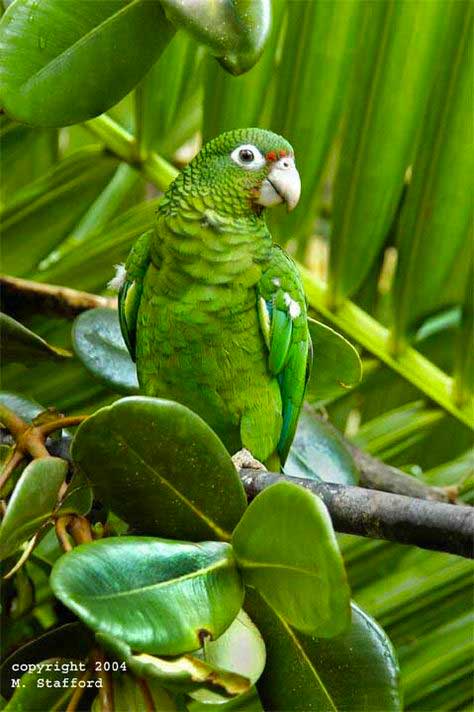
Several thousand varieties of tropical plants grow in Puerto Rico, including the kapok tree ("Ceiba") with its thick trunk, the poinciana (a prickly tropical shrub with brilliant reddish blossoms), the breadfruit, and the coconut palm. A tropical rain forest in the northeastern section of the island has tree ferns, orchids, and mahogany trees; part of this tropical area is included in the Caribbean National Forest. In the dry southwestern corner of Puerto Rico are cactus and bunch grass. Puerto Rico has no large wild mammals. The mongoose was brought in to control rats on sugar cane plantations. Iguanas and many small lizards abound, and bats are present. The island has few animals native to the island, found almost nowhere else in the world, the coquí (mentioned above) and the Puerto Rican Parrot (Amazona vittata) ("cotorra puertorriqueña") lives only in a few hidden areas of the Caribbean National Forest. The Puerto Rican Parrot is bright green, about a foot in length, with red forehead, blue primary wing feathers, and flesh-colored bill and feet. Barracuda, kingfish, mullet, Spanish mackerel, tuna, lobster, and oysters are among the many fish inhabiting coastal waters.
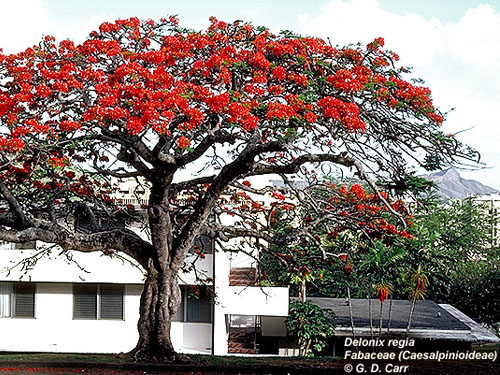
Poinciana
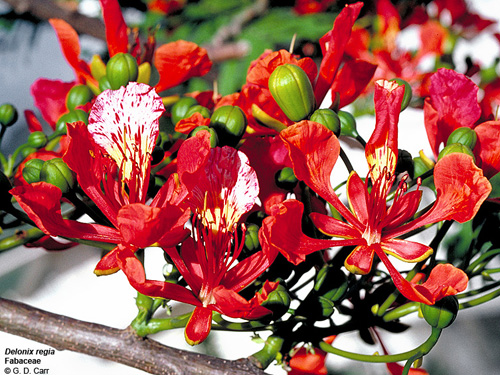
Poinciana
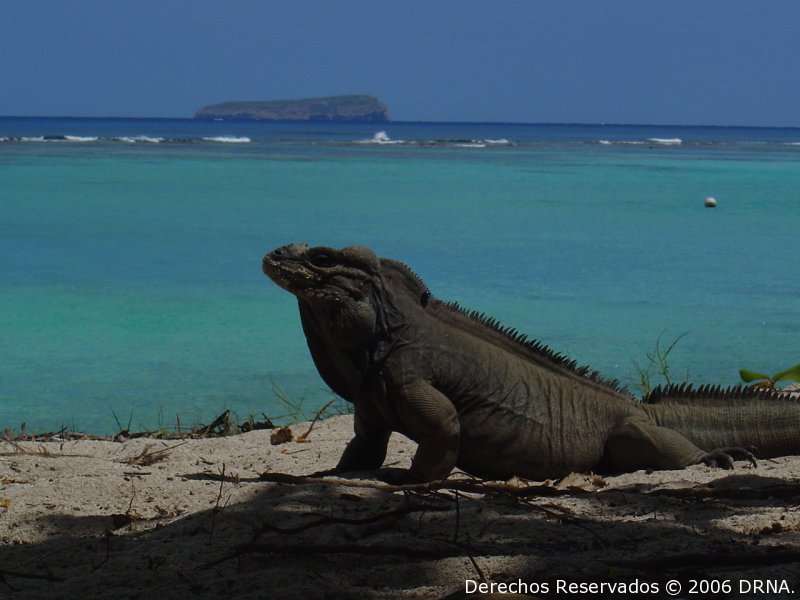
Iguana
Natural Resources
Some stone, fish, copper and nickel, potential for on-shore and off-shore crude oil.
Land Use
- agricultural land: 22%
- arable land: 6.6%
- permanent crops: 5.6%
- permanent pasture: 9.8%
- forest: 63.2%
- other: 14.8% (2018 est.)
Irrigated Land: 220 sq km (2012)
Natural Hazards: periodic droughts; hurricanes
Environment Current Issues: erosion; occasional drought has caused water levels in reservoirs to drop and has prompted water rationing.
Many small rivers and high central mountains ensure land is well watered; south coast relatively dry; fertile coastal plain belt in north.
Note: important location along the Mona Passage - a key shipping lane to the Panama Canal; San Juan is one of the biggest and best natural harbors in the Caribbean.
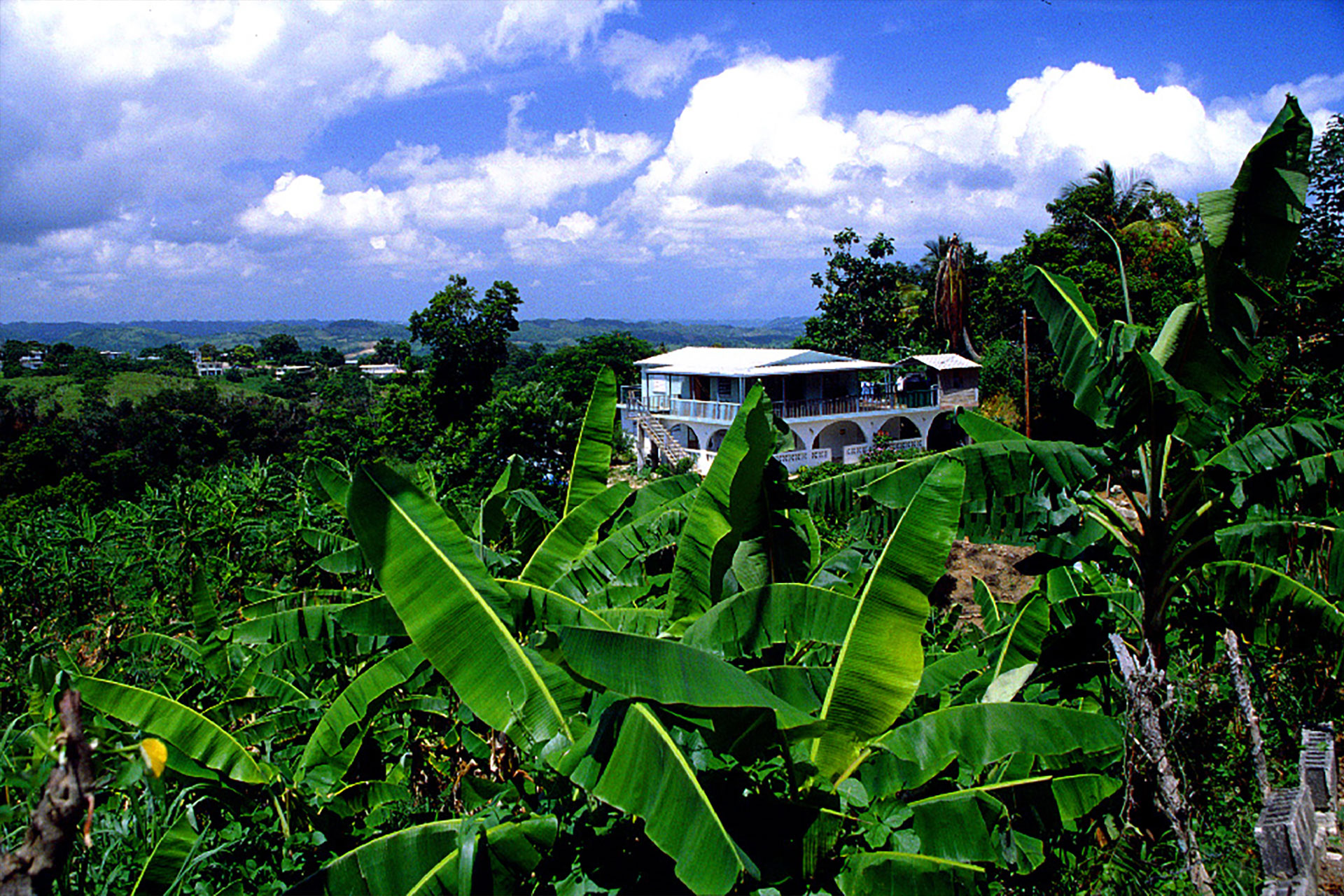
Hydrography
Of the 1,200 bodies of water Puerto Rico only classifies 50 of them rivers. Numerous rivers flow down from the mountains to distinct coastal plains. The Central Range divides the north (Atlantic) and south (Caribbean) watersheds. The northern rivers are long, rich and tranquil waters in comparison to the southern rivers, and the coast is wet and green. The major rivers are: Grande de Loíza (65 km), Bayamón (40 km), La Plata (80 km), and Grande de Arecibo (55 km). To the west and the east are the rivers basins which form the water systems and these rivers are: Culebrinas (45 km), Grande de Añasco (65 km), and Guanajibo (36 km). Subterranean streams are abundant, especially toward the northwest. Between the most important thermal fountain is "Los Baños de Coamo" found in Coamo. In the southwest, mangroves have created a unique canal system. Puerto Rican rivers are not navigable by large vessels, but they provide electrical power and irrigation.
Climate
The climate is Tropical Marine with an average temperature of 80°F (26°C). Puerto Rico enjoys warm and sunny days most of the year. Lightweight clothing is appropriate year-round. The winds, which blow from the East, moderate temperatures and rainfall. In the interior, the temperature fluctuates between 73°F and 78°F (22°C and 25°C). The temperature in the south is usually a few degrees higher than the north and temperatures in the central interior mountains are always cooler than the rest of the island.
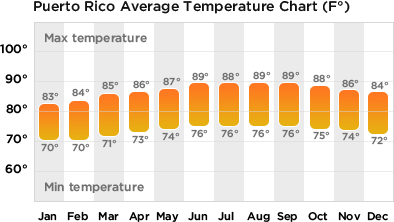
Rainfall tends to be evenly distributed throughout the year, but doubles during the months from May to October, which, unfortunately, coincides with hurricane season, as falls from November to April, with a driest period from January to April. The north coast gets twice as much rain as the south coast. Annual precipitation in the north is 1,550mm (61.02 inches); in the south is 910mm (36 inches), in coastal regions 101-381 cm (40-150 inches) and in the mountains 508 cm (200 inches).
The rainiest place of the island is El Yunque National Forest located in the northeast, where there is no real dry season, it rains year-round. With about 240 inches (6.1 m) per year, which translates to over 100 billion gallons of water. On the other hand, the driest place on the island is the Guanica Biosphere Reserve and State Forest, a desert-like forest located in the southwest region. With only about 30 inches (76.2 cm) of rain fall per year.
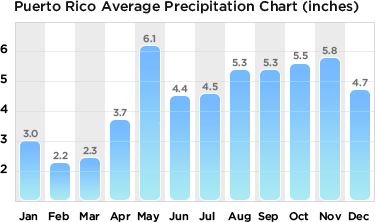
Hurricane Season in Puerto Rico
Because of Puerto Rico s location, the island is expose to frequent hurricane activity. Hurricanes frequently occur between August and October, although the U.S. National Weather Service considers the hurricane season for the North Atlantic Basin to run from June 1 to November 30. The North Atlantic Basin includes the Atlantic Ocean, the Caribbean Sea, and the Gulf of Mexico. Hurricane seasons during 1995-2004 have averaged 13.6 tropical storms (34-63 knots), 7.8 hurricanes (>63 knots) and 3.8 major hurricanes (>95 knots).
Dozens of hurricanes have been recorded in the island's history, but probably the most destructive was San Ciriaco, which struck on August 8, 1899.
The relative humidity is high, about 80% throughout the year.
Time Zone: Atlantic Standard Time (AST), which is one hour later (+1) than Eastern Standard Time (EST) and four hours earlier (-4) than Greenwich Mean Time (GMT). Puerto Rico does not observe Daylight Savings Time.
Atlantic Standard Time (AST, GMT-4, Zone Q), which comprises Puerto Rico and the U.S. Virgin Islands.
The time in Puerto Rico is:
8:59 AM
Sunrise/Sunset Average: 6:54 am to 6:21 pm
Because of the latitude of Puerto Rico the sun is high overhead all year,
there are no great variations from day to day between the times of sunrise and
sunset.
Interesting Fact
Spanish or Castilian (español or castellano) is, like
French, Portuguese, Italian, an Iberian Romance language, derived from Latin. Spanish
is a phonetic language, words are pronounced exactly as they are spelled.
Other Resources
- Iguana de Mona (Photo source: Iguana)
- 1992 Census of Agriculture [PDF]
- National Weather Service Forecast Office - San Juan, PR
- Puerto Rico Perspectives (Cartographic maps)
- Current Conditions for Puerto Rico
- NOAA/AOML/Hurrican Research Division
- Puerto Rico
- Puerto Rico, Virgin Islands - Latest conditions, forecasts by USA Today
- Puerto Rico Trench
- San Juan Weather Report
Sources:
- Dr. Carr, Gerald (Gerry). Department of Botany and Plant Pathology. Retrieved 2020 from http://www.botany.hawaii.edu/faculty/carr/ (offline). (Photos source: poinciana)
